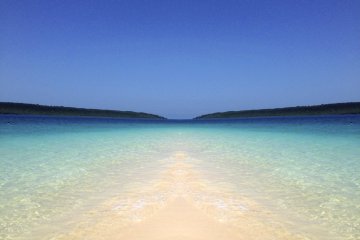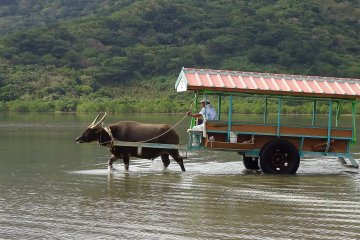Over the years, I have posted articles on attractions in Japan, but this article is more about the journey than the destination. Traveling to the attraction is an attraction in itself for over 200K visitors every year to Yubu Island in Ishigaki.
In today's age of bullet trains and jet travel, the attraction lies in the modest water buffalo cart which wades through water to transport you across two islands. Yes, you read that right, a water buffalo cart in Japan!
The concept of water buffalo rides as a tourist activity gradually developed from the deep-rooted history of Yubu Island. A scarcely populated island before 1945, Yubu Island came to be inhabited after World War II by farmers who relocated from Kuroshima and Taketomi Islands nearby. Their intention was to protect themselves from malaria (rampant during the world war) on this island, which had no mosquitoes. Soon, as cultivation thrived and sugarcane and pineapple industries flourished, inhabitants became rich enough to own water buffaloes for farm work. Their utility as a mode of travel came to be when the Syunpu-Maru Liner (operating from Ishigaki to Yubu Island in those days) could be operated only during high tides. The liner gradually got replaced by the water buffaloes for carrying goods. The water buffaloes ensured the availability of continuous transport, regardless of the spring tide conditions.
The ride starts from the Water Buffalo Cart Station which is just twenty minutes away from the Ohara port in Iriomote, by a fixed-route bus. The water buffalo cart is presided by a guide and takes you across the sea to Yubu Island in around 20 minutes. However, from my personal experience, two factors determine the duration of the ride:
First, during high tide, it becomes difficult for the water buffalo to move across, in which case the ride may take longer. Visiting during low tide is recommended if your schedule for the day is completely blocked. Second, the fate of the ride totally comes down to the whims and fancies of the water buffalo. When the buffalo gets bored, it will just stop midway! CUTE!
This is something that I personally experienced. The water buffalo that was taking me along with my family suddenly stopped moving and we weren’t even close to the destination. His name was Shota, as the guide called him. The guide joked about how like us humans, even Shota hated to work and he had to be pushed to continue. This hilarious incident is still fresh in our memory.
It turns out that the water buffaloes frequently get bored and the guides have come up with a unique way to solve the problem. Apart from leading the cart, the guides keep the buffaloes entertained by playing the Shamisen (a three-stringed traditional Japanese instrument). While the instrument is played for the entertainment of the buffalo, it also enhances the experience of the riders, who feel like they have been transported to ancient Japan.
For me, the best part of the ride is being able to look around at the beauty of the sea, leisurely moving from one island to another, with the sound of the Shamisen in the background. I personally felt that the ride transported me somewhere else.
As all good things should, the ride did end with an opportunity to take a photo with our water buffalo. They give you a printed version too to take home for a lovely memory. Overall, this an experience that you should definitely not miss in Ishigaki. I do not know of any other location in Japan offering a water buffalo ride. Shinkansen is basic, buffalo cart is COOL!















